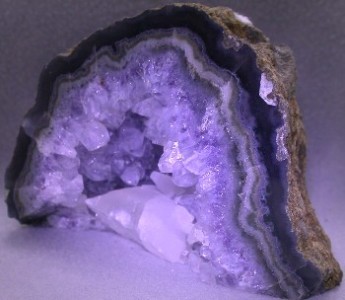WEBSITE HIGHLIGHTS: CANADIAN DIAMOND BRANDS
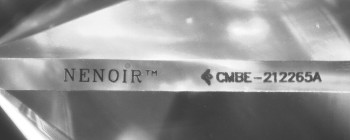 The diamond mines and cutters in Canada have taken a unique strategy of branding their diamonds to add value in the eyes of the consumer. Never before has the source of the diamond been marketed. Some of the diamonds are laser inscribed with these brand markings and sometimes the brand is a paper document that goes to the buyer of the diamond.
The diamond mines and cutters in Canada have taken a unique strategy of branding their diamonds to add value in the eyes of the consumer. Never before has the source of the diamond been marketed. Some of the diamonds are laser inscribed with these brand markings and sometimes the brand is a paper document that goes to the buyer of the diamond.
Learn more about Canadian Diamond Brands
DIAMOND SHOPPER MISTAKES: WHAT IF I WAIT
What if I wait? This is the question we often hear after we have found the best diamond in the country meeting our client’s requirements. The reason for their question often has more to do with the commitment to propose than it does with selecting the right diamond.
 When we ask them what it is that they are waiting for, our client will often say that there might be a better diamond to come on the market and they have some time before they plan to propose. Our question back to them is usually, “What is it that you are looking for that is different than the diamond we have found for you?” Generally, there is no answer to this question other than they just think there might be something better if they wait.
When we ask them what it is that they are waiting for, our client will often say that there might be a better diamond to come on the market and they have some time before they plan to propose. Our question back to them is usually, “What is it that you are looking for that is different than the diamond we have found for you?” Generally, there is no answer to this question other than they just think there might be something better if they wait.
It has been our experience that waiting usually results in one of the following outcomes:
1) The price of the diamond goes up so the budget ends up meaning a smaller diamond has to be purchased. When the price of rough diamonds goes up, the price increase filters through the industry to increase the price of polished diamonds on the wholesale market in a week or two. Diamond prices have been going up 5% to 10% per year recently and the timing of the increases during the year is difficult to predict.
2) The indecisive shopper waits too long and suddenly has to settle for the diamond that can be set in the mounting the quickest. Custom design mountings can take 2 to 6 weeks depending on the style. Sometimes the diamond shopper gets so involved with the diamond part of the ring, they forget that the designer mounting can take weeks to make. The production time grows longer as the designers get busier approaching the end of year holidays.
3) The best diamonds that were available are sold and there is nothing as good in the budget so they have to compromise on one or more of the specifications, usually the size of the diamond. While there are always plenty of one carat round diamonds available, harder to find shapes, sizes or color/clarity combinations are not abundant. This is especially true of diamonds over three carats because the supply of rough crystals is very limited and prices are higher than in recent years.
4) The shopper becomes so frustrated by not being able to make a decision, the process that started as a labor of love, becomes a labor of anger. The ego takes over and the shopper ends up picking something completely different than they started with; just so they can be done with it. Often this means walking into a jewelry store and buying something in their display case even though it costs thousands of dollars more and is not near the quality of the diamonds they passed up before. They seem to take out their frustration on the person who is going to be wearing the ring.
TOLKOWSKY CUT PROPORTIONS
Around 1900, improvements in diamond cutting tools such as diamond saws and lathes, make it possible for diamond cutters to take the next step in modern diamond cutting. In 1919, Marcel Tolkowsky used mathematical calculations to derive cut proportions to optimize brilliance and fire.
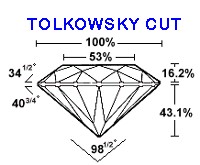 The diamond cut proportions proposed by Tolkowsky are often labeled as being “ideal” and were the industry standard for decades. While the Tolkowsky cut (also known as the American Standard, American Ideal and Tolkowsky Brilliant) produce beautiful diamonds, the industry has known for years that diamonds cut to other proportions can be just as beautiful so the Tolkowsky parameters were not the only “ideal” cuts. In fact, Tolkowsky himself never used the word “ideal” in his “Diamond Design” publication. He used the phrases “best proportions,” “well-cut brilliant” and “high-class brilliant.” He also acknowledged that there was a much wider range of diamond proportions that yield “the liveliest fire and the greatest brilliancy.”
The diamond cut proportions proposed by Tolkowsky are often labeled as being “ideal” and were the industry standard for decades. While the Tolkowsky cut (also known as the American Standard, American Ideal and Tolkowsky Brilliant) produce beautiful diamonds, the industry has known for years that diamonds cut to other proportions can be just as beautiful so the Tolkowsky parameters were not the only “ideal” cuts. In fact, Tolkowsky himself never used the word “ideal” in his “Diamond Design” publication. He used the phrases “best proportions,” “well-cut brilliant” and “high-class brilliant.” He also acknowledged that there was a much wider range of diamond proportions that yield “the liveliest fire and the greatest brilliancy.”
The Tolkowsky brilliant cut specified proportions as follows:
- Table percentage 53%
- Crown height percentage 16.2%
- Pavilion depth percentage 43.1%
- Crown angle 34.5 degrees
- Pavilion angle 40.8 degrees
Tolkowsky’s original publications assumed a “knife edge” girdle. Cutters knew they needed some girdle thickness for durability. As a result, they modified Tolkowsky’s original brilliant cut proportions to include girdle thickness as follows:
- Girdle percentage 2.2%
- Depth percentage 61.5% (crown + pavilion + girdle percentages)
The term “Tolkowsky Cut” is used quite loosely on some diamond grading reports. The words “Tolkowsky Cut” do not necessarily mean that the cut of the diamond is to Tolkowsky’s exact specifications. Some laboratories like the European Gemological Laboratories (EGL) will imply that a diamond is “Tolkowsky Cut” or within “Tolkowsky Range” if the diamond’s proportions are just close to Tolkowsky’s original calculations.
BROWN: THE MOST COMMON DIAMOND COLOR
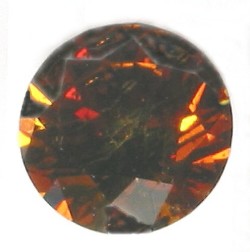 If you examined the daily output of diamond mines worldwide, you would see that the most common color of diamonds is brown. Historically, the brown tone diamonds have not been popular for jewelry, as consumers preferred the whiter, brighter colors. For many years, brown diamonds were used exclusively for “industrial” purposes.
If you examined the daily output of diamond mines worldwide, you would see that the most common color of diamonds is brown. Historically, the brown tone diamonds have not been popular for jewelry, as consumers preferred the whiter, brighter colors. For many years, brown diamonds were used exclusively for “industrial” purposes.
This situation changed dramatically in the mid-1980s when Australian diamond marketers launched a campaign to change the public’s perception for brown diamonds. The catalyst for this campaign was the large volume of brown diamonds mined at the Argyle mine in Western Australia. By using the “champagne” name for lighter stones and “cognac” for darker stones, the campaign transformed the consumer’s perception of browns from “industrial” to “glamour” status.
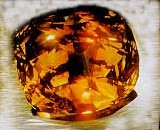 The Golden Jubilee is one of the most famous brown diamonds. Discovered in 1986 in the Premier mine in South Africa, this diamond was originally called the Unnamed Brown and weighed 755.5 carats as a rough crystal. The stone was cut into a fire-rose cushion shaped diamond with 148 perfectly symmetrical facets, weighing 545.67 carats making it the largest diamond ever cut. It was presented to the King of Thailand in 1997 for his golden jubilee, the 50th anniversary of his reign.
The Golden Jubilee is one of the most famous brown diamonds. Discovered in 1986 in the Premier mine in South Africa, this diamond was originally called the Unnamed Brown and weighed 755.5 carats as a rough crystal. The stone was cut into a fire-rose cushion shaped diamond with 148 perfectly symmetrical facets, weighing 545.67 carats making it the largest diamond ever cut. It was presented to the King of Thailand in 1997 for his golden jubilee, the 50th anniversary of his reign.
TEN COMMANDMENTS DIAMOND
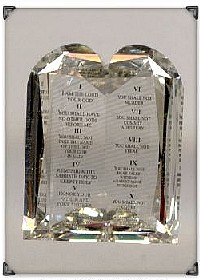 Trillion Diamond Company, perhaps best known for creating the trillion-cut diamond, recently received a Registered Trademark on the expression “Ten Commandments Diamond®.” Marvin Finker, President of Trillion Diamond Co. also announced the creation of a new website www.tencommandmentsdiamond.com to promote their fascinating diamond shape.
Trillion Diamond Company, perhaps best known for creating the trillion-cut diamond, recently received a Registered Trademark on the expression “Ten Commandments Diamond®.” Marvin Finker, President of Trillion Diamond Co. also announced the creation of a new website www.tencommandmentsdiamond.com to promote their fascinating diamond shape.
The words of the original Ten Commandments are permanently laser inscribed on the table facet of the new diamond shape and are easily read with a magnifying glass. The diamonds are usually set in pendant mountings to protect the diamonds and best display this unique shape.
INCLUSIONS & BLEMISHES: FEATHER-DIFFERENT VIEWS
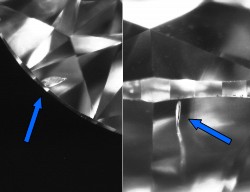 Inclusions are three dimension objects so they appear different from different perspectives. When the feather near the girdle is viewed from the top (left side of photo), it has a very different appearance than when viewed from the side (right side of photo).
Inclusions are three dimension objects so they appear different from different perspectives. When the feather near the girdle is viewed from the top (left side of photo), it has a very different appearance than when viewed from the side (right side of photo).
When we inspect diamonds for clarity, we are constantly rotating and turning the diamond so that we can see the inclusions from various angles. The different views of the inclusion enable us to better identify the type of inclusion, plot its true location, and assess visibility. While clarity is graded viewing the diamond from the top, at Diamond Source of Virginia we feel the side view is just as important. Inclusions just below the girdle and near the outer edge of the diamond are often hard to see from the top but can be more visible from the side.
GOLD PRICES HIT 25-YEAR HIGH
 The price of gold hit a 25-year high the first week of April in London causing consumers worldwide to curb their gold jewelry purchases. Typically, commodity prices go up due to demand being greater than supply, but the demand for gold is actually declining and is lagging production.
The price of gold hit a 25-year high the first week of April in London causing consumers worldwide to curb their gold jewelry purchases. Typically, commodity prices go up due to demand being greater than supply, but the demand for gold is actually declining and is lagging production.
Gold bullion traded at $591.92 an ounce, the highest price since January of 1981.
Gold demand from jewelers dropped 15 percent in the fourth quarter, which was the largest single quarter decline since the first quarter of 2002. Jewelry prices were projected to be weak the first quarter of 2006 and the recent high prices will probably ensure that trend will continue.
GEMSTONES: AMETHYST
Amethyst, the traditional birthstone for February, is typically a transparent variety of quartz that comes in shades of purple. The purple coloring results from iron or manganese impurities in the silicon dioxide (quartz). The natural abundance, exceptional variety and beautiful color of amethyst make it one of the most widely used of gemstones.
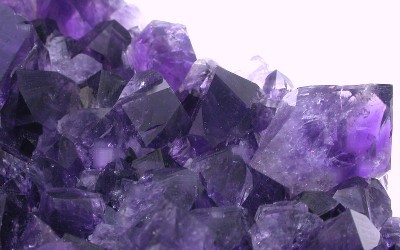
The name “amethyst” is derived from the Greek term for “not drunken” and has long been a symbol for sobriety. Throughout history, Amethyst has been used to adorn the possessions of rich and powerful monarchs including some of the stones that decorate the British Crown Jewels. Amethyst was a personal favorite of Catherine the Great. During the Middle Ages, the stone symbolized piety and celibacy for clergy and therefore adorned the rings and other jewelry of Cardinals, Bishops, and Priests of the Catholic Church.
In Greek mythology Dionysus, the god of wine and song, was angry and vowed to slay the first mortal who crossed his path. That unlucky mortal was Amethyst, a beautiful maiden. However, Artemis (goddess of virginity and the hunt) intervened and transformed Amethyst into white stone. At this point, Dionysus repented and poured wine over the stone, staining the top of it purple. That is why the top of amethyst is purple and the bottom is often white.
Amethyst crystals are hexagonal and can occur as tall prismatic crystals or short stubby ones. The crystals often have horizontal striations on their sides or faces. The transparent prismatic crystals can be found in clusters in an incrustation (rock cavity). This lining of crystals is also known as a druse and in a nodular stone is commonly called a geode.
There are several varieties of amethyst in addition to the traditional purple amethyst. These include Amethyst Quartz (layers of Amethyst and milky or clear quartz), Ametrine (layers of Amethyst and Citrine which is a orange-yellow gemstone), Canadian Amethyst (Amethyst with internal red Hematite is only found at Thunder Bay, Ontario), Lavender Amethyst (pale purple Amethyst), and Veracruz Amethyst (prismatic Amethyst crystals from Vera Cruz, Mexico).
Amethyst exists in many areas around the world, including Mexico, Brazil, Uruguay, Sri Lanka, Namibia, Madagascar, and Russia. In the United States, Amethyst originates in Montana, Arizona, Colorado, Maine, and New Jersey. In Canada, Amethyst sources are near Thunder Bay and in Nova Scotia. Typically, amethyst from South America is available in larger sizes than African amethyst but amethyst from Africa has the reputation for having better, more saturated, color in small sizes. Very dark amethyst, mostly in small sizes, is also mined in Australia.

